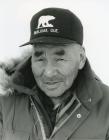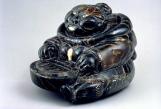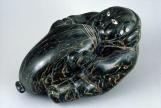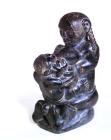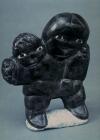2
Johnny Inukpuk [1911 - 2007]"The hardest thing is to get the carving stone out of the ground. It is very hard work to try and get stone to carve. Sometimes the tools are not always up to standard; we use shovels and other hand tools to remove the stone from the ground. At the quarry there are huge boulders on top of the stone we carve. It would be good to blast these boulders and remove them with a bulldozer, but we do not have the means to do this." (interview with Inuit Art Foundation staff in Inukjuak in 1998).
"The carvings back then used to be really cheap. Saumik (James Houston) was the one who encouraged people to carve, so I did. Carving gave us an independence that we never previously had." (ibid)
"It seems to me that the young people will not continue [carving] because they have a tough time breaking into the art world. They get discouraged because their pieces are not being bought by art collectors." (ibid.)
His story
Inukpuk began carving in the early 1950s, after James Houston's first visit to Inukjuak. His work was part of a collection of Inuit art that was purchased by the TD Bank Financial Group in 1951. Hunter, measuring 49.5 x 36.8 x 21.5 cm, was part of that collection, and, according to 1962 correspondence between C.A. Stewart of the Hudson's Bay Company and Budd Feheley of the Toronto-Dominion Bank, it possibly represents the first large figure produced by Canadian Inuit at that time. Inukpuk gained attention in 1953, when his work was shown in Eskimo Carvings (known as "The Coronation Exhibition") an exhibition held at Gimpel Fils in London, England. In 1978, he was elected a member of the Royal Canadian Academy of Artists.
His art
For the most part, Johnny Inukpuk used dark green serpentine stone for his sculpture. Darlene Wight, curator of Inuit art at the Winnipeg Art Gallery thinks that "he was particularly skilled in locating excellent pieces of carvingstone" which she described as being "characterized by pronounced translucent layers that glow in the light, and by gold patches that enhance this opalescent effect." As she said, "Inukpuk made intelligent use of this colourful stone by reducing carved details and creating smooth, round forms that are polished to a shiny brilliance" (2006:84). Inukpuk is best known for the work he made in the 1950s and 1960s. It invariably shows a figure in the act of doing something: feeding a child, cooking, blowing up an avataq (sealskin float), or stretching out a sealskin line. This concern for details of daily life has been a trademark of sculpture from Inukjuak since the early contemporary period. Inukpuk's wife, Mary, had a harelip, which was reflected in several of his female sculptures. The drilled eyes of his earlier works were eventually replaced by soapstone and ivory inlay; black eyes were achieved by melting down vinyl records.
Inukpuk made only one print, entitled A True Story of Johnny Being Attacked by Three Polar Bears While in His Igloo (1974). According to Marybelle Myers (Mitchell), who described the piece in the Arctic Quebec 1974 print catalogue, the print was made to document a real life hunting experience: "While hunting one winter, Johnny built himself a small overnight igloo. He was caught unaware by three polar bears, and, since he had left his rifle outside, had to fend them off with a stick. Though he was a famous carver, he felt that he could not adequately tell this story in stone. He discussed it with the hunters in his community and, together, they decided the tale could best be told by means of a stonecut print. Johnny knew nothing about printmaking, but his inspiration guided him to the creation of a sincere and charming print" (p. 2).
References
Myers, Marybelle (Mitchell)
1974 "Arctic Quebec 1974 II", in 1974 Prints Arctic Quebec II. La Fédération des Coopératives du Nouveau-Québec: 2
Stewart, C.A.
1962 Letter to Budd Feheley, quoted in 2006, Darlene Wight, Early Masters: Inuit Sculpture 1949-1955. Winnipeg: The Winnipeg Art Gallery: 84
Wight, Darlene
2006 Early Masters: Inuit Sculpture 1949-1955. Winnipeg: The Winnipeg Art Gallery.
5
"Mother and Child Playing String Game" by Johnny Inukpuk1956-60
Inukjuak, Quebec, Canada
 Credits:
Credits:Photo: Ernest Mayer
6
"Story - Polar Bears are Stronger than Walrus" by Johnny Inukpuk1958
Inukjuak, Quebec, Canada
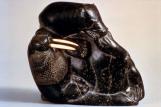 Credits:
Credits:Photo: Paul von Baich
8
"Man Wringing Seal Line" by Johnny Inukpuk1964
Inukjuak, Quebec, Canada
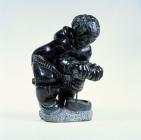 Credits:
Credits:Photo: Richard Garner
9
"A True Story of Johnny Being Attacked by Three Bears While in His Igloo" by Johnny Inukpuk1974
Inukjuak, Quebec, Canada
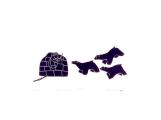
10
"Man and Raven over Skeleton" by Johnny Inukpuk1978
Inukjuak, Quebec, Canada
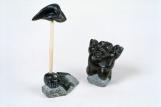 Credits:
Credits:Photo: Michael Neill
11
Carving by Johnny Inukpuk1982
Inukjuak, Quebec, Canada
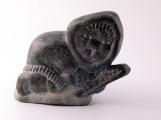 Credits:
Credits:La Fédération Coopératives du Nouveau-Québec
Photo: Bernard Murdoch
13
"Man with Dog Harness" by Johnny Inukpuk1967
Inukjuak, Quebec, Canada
 Credits:
Credits:Photo: Michel Bouchard
14
"Mother and Child" by Johnny Inukpuk1987
Inukjuak, Quebec, Canada
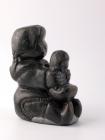 Credits:
Credits:La Fédération Coopératives du Nouveau-Québec
Photo: Bernard Murdoch
